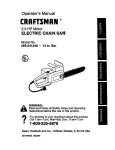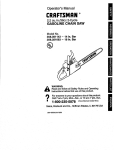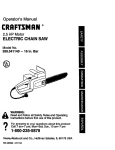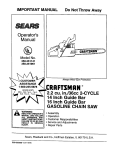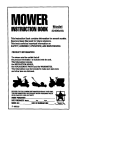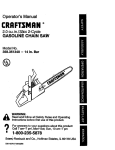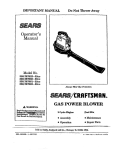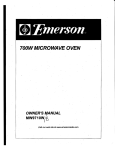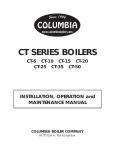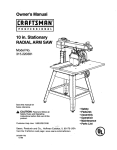Download Craftsman 358.341240 Operator`s manual
Transcript
Operator's Manual 2.5 HP Motor ELECTRIC CHAIN SAW CRAFTSMAN+ Model No. 358.341240 -- 14 in. Bar ® Read and foilow alJ Safety Rules and Operating ARNING: Instructions before first use of this product. _ For answers to your questions this product: Call 7 am-7 pm, Mon-Sat; Sun,about 10 am-7 pm • 1-800-235-5878 Sears, Roebuck and Co., Hoffman 5,.qo-orte_z oai24/oa Estates, IL 60179 USA i Warranty Safety Rules Assembly Operation Maintenance 2 2 7 7 12 Service and Adjustments Storage Trouble Shooting Spanish Parts Ordering 13 15 15 18 Beck FULL ONEYEAR WARRANTY ON CRAFTSMAN ELECTRIC CHAINSAW. If this Craftsman Electdc Chain Saw fails to perform properly due to a defect in matedai or workmanship within (1) year from the date of purchase, Sears will repair or replace it, fr.ee ofc.har,ge. This warranty excludes the bar and ch_,n, wnnchare expendable parts and become worn during normal use. If this Craftsman Electdc Chain Saw is used for commercial purposes, this warranty applies for only 90 days from the date of purchase. If this Craftsman Electric Chain Saw is used for rental purposes, this warranty applies for only 30 days from the date of purchase. This warranty applies only while this product is in use in the United States. WARRANTY SERVICE IS AVAILABLEBY RETURNINGTHE CRAFTSMAN ELECTRIC CHAIN SAW TO THE NEAREST SEARS SERVICE CENTER IN THE UNITEDSTATES. This warrant ; you specific legal dghts, and you may also have other rig r from state to state. Inc., IL 60179 U.S,A. : When using an electric chain saw. basic safety precautions, including the following, should aiweys be followed to reduce the risk of fire, electric shock, and injury to persons. Read all instructions. WARNING: AlwayscrJsconned power banters(earplugsor mufflers)to protectyourhearing.Regularusers shouldhave hearingchecked regularly as chainsew noisecan damage hearing. H=,_r_ _ _ s_,ty Hat source when maldng repairs. Besause a Prote_on _'_ O_ Eye chain saw is a high.speed woodcuttieg tool, careless or improper use of thistool Snug -----b. ,_ Protsctlon can cause sedous injury. PLAN AHEAD • Restrictthe use of your sew to adult users who understandand can follow the s=fety rules, preceutJc_s,and oparai_ng insbuslJonsfound in this r'ni_ual. • Kesp childran away. Do not ist visitors illi_ contest chain eaw or exlansion cord. All visitorsshoold be kept at isest 80 f_,t • Secure hair above shoulder isngth. Do (10 metem) et#ay from w_k area. • Dress properly.Wear protective gear. cen ga ceugnt rL mo_.ngip_s. Al_hYS use steel-toed safetyfootwear • Keep ell par_sof your _ away from non-slip soles; snug-fitting cloththe chain when sew is nJnning. ing; heavy-duty, non-aiip gloves; eye • Do n_ handfe ar oben_e e chain saw protection such as non-fogging, whan you ara _ued, ilI,ups_, ar _ vented goggles or face screen; an epyoo have takan aicoho_, dru_, ar n_ "# i "" oo_ dication.You must be in good physical ; Keep the handles dry and clean and conditionand mantallyalert, fi you have free from oil and grease. any conditionthat might be aggravated • Keep oil cap and fasteners sauuraly tightened. by stranunuswork, check with doctor • Konconfom_ng_ compobeforeoper_ng. nents or the removal of sandy devioss Watch whet you ere doing. Use commay _e danlage to lhe un_ and mon sense. pussiblein.luryto the operatoror by• Do not start cutting until you have a standers, Use c_lJy Cra_smanasosasoclear work area, secure footing, and especially if you are felling a tree, a dasand rsple_anant Pertsas recomretreat path. Keep work area clean. mended. Never modify yoursaw. • Maintain chain saw with care. Cluttered areas invite injuries. • Keep unit sharp and clean for better OPERATE YOUR SAW SAFELY and safer performance. • Do not operate with one hand. Seri• Follow instructions for lubricating and ous injury to the operator, helpers, or changing accessories. bystanders may result from one• Unplug the chain saw from the power handed operation. A chain saw is insouroswhan nsHn use,b_ se_tended for two-handed use. ing, and when changing accessories • Do not operate saw from a ladder or and attashmants, such as saw chain in a tree. • Make sure the chain will not make and guard. • Cbeckfordamagsdparts.Befo_ furcontact with any object while starting the saw, Never start the saw when the theruse of the chain caw, a guerd or other part that is dernagsd should be guide bar is in a cut, carefunychecked to detemCne th_ it • Don't force chain saw. It will do the job better and safer at the rate for which it will opande properlyand perform b inwas intended. tended func_on, Check for alignment of • Do not put pressure on the saw, esmov_gp_s, un_ngofmov_gParts, pecially at the end of the cut. Doing breakage of parts, rnounlJngand any so can cause you to lose control other coedi_onsthat may effectits opwhen the cut is completed. ersfJon.A guard or oS"terpart that is dan'Bged shouJdbe propedyrepaired • Stop the saw before setting it down. Hand carry saw only when motor is or replaced by a Sears Service Center stopped. Carry the chain saw by the unlessothenNiseind'K_.edelsewhere in front handle with the saw stopped, finthe operator'smanual. gsr offthe switch, the guide bar and • Do not operate a chain sawthat is saw chain to thb rosr, damaged, improperly adjusted, or is • Use the right tool, cut wood only. not completely and securely asDon't use chain saw for purpose not sembled, Inspect chain saw cords peintended; for example, don't use riodically,and if damaged have rechain saw for cutting plastic, masonry, p_red by a Sears Service Center. • When not in use, chain saws should non-wood buildin_ matedale. • Use extreme caution when cutting be stored in a dry, high or locked-up small size brush and saplings beRl_eceout of the reach of children. cause the tender material may catch • When storing saw, unplug and use a the saw chain and be whipped toward bar sheath or carrying case. Store idle chain saw. you or pull you offbalance. • When cutting a limb that is under tenELECTRICAL SAFETY sion be alert for spring back so you Use a vo[_gs supply as shown on unit. will not be struck when the tension in Avoid dangerous environments. Don't the wood fibers is released. use appliances in damp or wet locaMAINTAIN YOUR SAW IN GOOD tions. Don't use in rain. WORKING ORDER • Avoid dangerous situations. Do not use in the presence of ifanvnable liq• Have all chain saw sarvice performed by a Sears Servica Center except the uids or gases to avoid creating a fire items listed in the maintenance secor explosion and/or causing damage to unit. tion of this manual. • Make certain saw chainstops moving when trigger switch is released. I • To reduce the riskof electdcel shock, this appliance has a poledzad plug (one blade is wider than the other) and will require the use of e polarized extensi_'_cord.The appflance plug will fit into a poiodzedextension cord only one way. If the plug does notfit fully intothe extensioncord, reverse the plug, If the plug stilldoes not fit, obtain a correct poisrized extension cord.A polarized extension cord win require the use of a polarized walt outlet.This plug will _t intothe poledzed w_dloutlet only one way. If plug does not fitfully into the wall ou_et, reverse the plug. If the plug sblfdoes not fit, contact a queli_ed electricianto installthe properwail outlet. Do not change the equipment plug, extensioncord receptacle, or extension cord plug in any way. • To reduce risk of electrical shock, use e)dec_ion colds sped_-_ly i'_lrked as suitable for outdoorappllet_as having electdcai raitngnot less than the rating of unit. Cord must be marked with suffix "W'. Make sure your extenaion cord is in good concfition,Insped exlension cord before use and replace If damaged. An undersized extension cord will cause a drop in line voltage resulting in loss of power and overhea_ng. If in doubt, ,Re the next heavier gauge. The lower the gauge number, the heavier the cord (see 'Select an extension cord'), • Do not abuse cord. Never carry the unit by the extension cord or yank extension cord to disconnect unit. • Secure extension cord to power cord to prevent disconnection from unit. • Do not use the unit if the switch does not turn the unit on end off properly, or if the lockout does not work. Repairs to the switch must be made by a Sears Service Center. • Keep extension cord clear of operator and obstacles at all times. Position cord so that it will not be caught on branches. Do not expose cords to heat, oil, water, or sharp edges. • To avoid the possibitity of electric shock, avoJd body contact with any grounded conductor, such as metal fences or pipes. • Ground Fault Circuit Interrupter (GFCi) protection should be provided on cimuit or outlet to be used. Raceptaulas ere avaitable having built-in GFCI protection and may be used for this measure of safety. Inspect chain saw cords pariodioally and if damaged, have repaired by a Sears Service Center. GUARD AGAINST KICKBACK Follow ell safety ruiss to help avoid kickback and other forces which can result in serious injury. Kkddxmk path C_earTheWoddngArea WARNING: Rotational Kickback can occur when the moving chain contacts an object at the upper portion of the tip of the guide bar, Contact at the upper portion of the tip of the guide bar can cause the chain to dig into the object, which stops the chain for an instant. The result is a tiQhtningfast, reverse reaction which kicks the guide bar up and back toward the operator. PinchJ_ckback and Pull-In occur when the chain is suddenly stopped by being pinched, caught, or by contacting e foreign object in the wood. This sudden stopping of the chain results in a reversai of the chain force used to cut wood and causes the sawto move in the opposite direotion of the chain rotation. Pinch-Kickback ddves the saw straight back toward the operator. Pull-in pulls the sew away from the operator. KICKBACK WARNING: Kicktmck c_ oca_ whan the moving chain contacts an obJact_ the upper podion of the tip of the guide bar or when the wood doses in and plnchas the saw chain in the cut.The Computed Wjdd_:eck Angle (CKA) _sted on your saw and listed in the following CKA Table represents the angle of ki_ your bar and chain combinationswighave when tested in accordance with CSA and ANSI standards, computed ang_ r_orasanted in the CKA oclumn iodicote total anergy ard angle _soci_',ed wiU_ut a chain brake. When purchasingreplacemer_, comider_ions shouldbe given to the lower CKA veluee. In ell casas, lower CKA vel- uesrepresent a safe" operatingenviron- mant for the user. Do not rely exclusively upon the safety devices built into your saw, • Either of these reactions may cause you to lose control of the saw which could result in serious injury. • Pinching the saw chain along the tip of the guide bar may push the guide bar rapidly back toward the operator. • Tip contactin some cases may cause a lightningfast REACTION.kickingthe guide bar up and back toward operator. CKA TABLE BAR MODEL _N CKA 7t-_617 111o OKA requirements per standard. REDUCE THE CHANCE OF The following pr_ should be fctlowed to rninirnizeIdckbeck: • Grip saw firmly. Hold chain saw firmly with both hands when motor is running. Use a fin-ngrip with thumbs and _ers encirclingchain saw handles. • Do not over reanh. KICKBACK I • Keep proper footing and balance at all times. • Don't let the nose of the guide bar contact e log, branch, ground or other obstruction. Don't cut above shoulder Use devices such as low height. kickback chain, guide bar nose _uards, chain • brakes, and special guide bars that CHAIN BRAKE & CKA ANGLE reduce the risks associated with kickWARNING: The effectivenessof a back, chain brake in reducing operatorinjuries • Only use replacement bars and hes not yat bean fully determined. We chains specified by the manufacturer cannot representthat a chain brake is an or the equivalent. effactivesafety deride to preveflt or reAvoid Plnch-KJekba_: duce the hazard of injuriesresultingfTom • Be extremely aware of situations or kickback. DO NOT ASSUMETHATTHE obstructions that can cause matefiat CHAINBRAKEWILLPROTECTYOU IN THE to pinch the top of or otherwise stop EVENTOF A K]CI<Z_CK.Instead, use the the chain. saw properlyand carefullyto avoid kick: _°Onct re°re than as °nethe I°gbar at a back. Reduced Kickback bars and Low not cut twist the sew is time' K_kback chainsreducethe hazard of withdrawn fToman undercut when kickbackand are recommended. Repairs bucking. Avoid Pull-In: on a chain brake shouldbe made by a Sears Service Center. Take your unit to • Always begin cuttingwith the sawat the place of purchase if purchesed from full speed and the saw housing a Servicing Center, or to the nearest against wood. Sears Service Center. • Use wedges made of plastic or wood, WARNING: Computedkickbackangle Never use met_ to hold the cut open. (CKA) Ibted on your saw and listed in the MAINTAIN CONTROL: CKA table represents angle of The following precautions should be folyour bar and chain combinations will lowed to minimize kickback. have when tested in accordance with • A good, firm grip on the sew with both C,SA and ANSI standards. When purhands will help you maintain control. chasingreplacement bar and chain, conDon't let go. Grip the rear handle with s_ should be given to the lower your right hand whether you ere right or left handed. CKA values. Lower CKA values represent safer angl_ to the user, highervatues indicatemorn angle and higher kick energies. In all cases lower CKA values represente safer operating environment for the user. The guide bar and chain combination(s) shown in the CKA Table meet kickback requirements of CSA Z62.1, Z62.3, & • Wrap the fingers of your left hand over and around the fiont handlebar, ANSI B175.1 when used on saw(s) listed and your left thumb under the front in thismanual. Use of bar and chain comhandlebar. binations other than those listed is not recommended and may not meet the 36B,_141240 _ 5 • Low Kickback Chain has met kickback performance requirements when tested on the representative sample of these chain saws specified in ANSI B175.1. LowIqd(back Chain • When making bucking or pruning cuts, position your left hand on the front handlebar so it is in a straight line with your right hand on the rear handle. Stand slightly to the left side of the sew to keep your body from being in e direct line with the cutting chain. Keep your left arm straight with the elbow locked, • Stand with your weight evenly baienced on both feet. • Do not ovoneach. You could be drawn or thrown offbalance end Inse control. • Do not cut above shoulder height. It is difficultto maintain control of saw above shoulder height. KICKBACK SAFETY FEATURES WARNING: The following features are included on your saw to help reduce hazard of kickback; however, such feetures will not totally eliminate this danger. Do not rely only on safety devices. • Handguard: designed to reduce the chance of your left hand contacting the chain if your hand slips off the front handlebar. • Position of front and rear handlebars: designed with distance between hendies and "in-line"with each other, The spread end "in-line" position of the hands provided by this design work together to give balance end resistance in controllingthe pivot of the saw back toward the operator if kickback occurs. • Reduced-Kickback Guide Bar: designed with a small radius tip which reduces the size of the kickback danger zone. This type bar has been demonstrated to significantly reduce the number and seriousness of kickbecks when tested in accordance with ANSI B175.1. SmallRadius Tip GuideBar Contoured D.pthGauge .ll_.._,---_ Ek_ngaiedGuard Unk AndAJow=WoodTo Gredu=dlyRideIntoCutter SAFETY NOTICE: Exposureto vibrations throughprolongeduseof handtoolscould cause bloodvesselor nervedamage in thefingers,hands, end Jointsof people proneto blrsulation disordersor abnormal swelling. Prolongedusein cold weatherhas been linkedto bloodvessaidamagein otherwisehealthypeople.Ifsymptoms occursuchas numbness,pain, lossof strength,change inskin coloror texture,or lossof feellngin the fingers, hands, or oints,discontinuethe use of ths too and seek med cel at'tenton. An anti-vibratlonsystemdoesnot guaranteethe avoidanceofthese problems.Userswho operatepower tools on e continualand regularbasis must closelymonitortheirphysical condition and the conditionof thistool. DOUBLE INSULATION CONSTRUCTION This unitis DoubleInsulatedto helpprotactagainstelectricshock.Doubleinsula. tioncomtn_on consists of twoseparate qayers"of alsotriceJ insulation insteadof J_oo_ ndmg° bu_ withthisinsuJatk_ systemare not intendedto be grounded.No grounding meansis providedon this unit,nor should• meansof groundingbe added tothis unit. Safety_ rnustbe o_P_.ved when operetingeny dectricoltool.The doubleins_ systemonlyprovides addedp_ againstinjuryresulting froman internalalactllcelinsulation failure. STANDARDS:Thisproductis listedby UnderwritersLaboratories,Inc. in accordencowith UL Standard1662 and CSA StandardsZ62.1 and Z62.3 end ANSI B175.1. SAVE THESE INSTRUCTIONS 6 CARTONCONTENTS Model35Q.341240 Chain Saw(fullyassembled) NOTE: If you need assbfence or find parts missing or damaged, please call 1-800-235-5878 ASSEMBLY Your saw is fully assembled; no assembly is necessary, Ear Sheath Extra Chain Bar Lube (8 oz,) Examine parts for damage. Do not use damaged parts. KNOW YOUR SAW READTHIS OPERATOR'SMANUALAND SAFETY RULES BEFORE OPERATING YOUR CHAIN SAW.Comparethe illustrations withyourunit to familiarlze yourselfwiththe locationof thevariouscontrols and adjustments. Save this manualfor future reference. OilerActuator/ BarOilCap Lockout Button TRIGGER SWITCH The rigger switah is used to tum on the unit. Squeeze the tdgger switch to operate the unit after lockout button has been pushed in. Release the tdgger to turn the unit off. LOCKOUT BUTTON The Lockout Button is e control feature designed to prevent the motor fi'om being accidently started. When the rear handle is gripped in a normal cutting position, the lockout button can be pushed in by the thumb,permitting the index finger to squeeze the trigger. It is not necessary to maintain pressure on the lockout button once the trigger has been angaaged. BAR OIL CAP/OILER ACTUATOR The oil Pap is used to access the bar oil tank and pressed to supply oil to chain. CHAIN ADJUSTMENT SCREW The chain adjustment screw Lsused to adjust the chain tension. RECESSED PLUG The receasedplugis used to connect the saw toan approvedexfensloncord. CHAIN TENSION Itis normalfor a new chainto sketch durinjgfirst30 minutesofoperation.You shouldcheckyourchaintensionhequentJy.ReadjostP.,haln a_er every 15 minutes of oparation,SesChain Tensionunderthe Serviceand Adjustments sec_on. OPERATING INSTRUCTIONS Use only a voltsge supply as speci_ed on your unit, Extensioncords are avaiisbis for this unit. Secure extsnsion_¢d to powar con:lto prevent disconnectionfrom unit. 7 I SELECT __ AN EXTENSION CORD • Stop the sew if the chain strikes e foreign object. Inspect the sew and repair parts as necessary. • Keep the chain out of dirt and sand. Even a small amount of did will quickly dull a chain and increese the possibilityof kickback, MINIMUMWIRE GAUGE RECOMMENDATIONS to1son. •Amerlram_ t4 12 A.W.G.* G_qle A,W,G.* the following steps. This will help you get the "feel"of using your saw before you begin e major sewing operation. _queeze the tdgger switch and allow unit to reanh full spesd before cuffing. Begin ouffng with the sew frame the log, e few small logs using i against Pre[aticecutting Ke_a the motor at full speed the entire time you ere cutting. Releese tdggar switch as soon as cut is comp!eted, Allowing motor to stop. • To avoid losing control when cut is complete, do not put pressure on sew at end of cut. • Stop.motor before setting saw down. TREE FELLING TECHNIQUES Check for broken or dead branches which can fall whge cutting c_=;_l sadous injury.Do notcut near buildingsor electriuslwiras if you do not know the directionof tres fell, nor out at nightsince you willnot be able to see well, nor during bad westher eu_ as rain,snow, strongwinds, etc. Ifthe bee makes con. tactwith any utilityline, the ublitycomplany shouldbe noUfiedimrnsdiately, • Carefully plan your sawing o_n in advance. _ roetemddur_ Oiling,on. Uee e fon- • Clesr the work eru. You nesd a desr eree dil around the tres so you can nel to fillthe tank. Replace oil cap sehave secure footing. curely. Check oillevel ester every 15 • Study the rm_ureJ conditJor_tha_ran minutes of operation. cause the tres to fall in e pefdouisr STOPPING YOUR SAW directbn, such as: • Release the tdgger switch. • The wind direction and speed. • If motor does not stop, disconnect the • The isan of the b'ee. The lean of e tree extension cord. STARTING YOUR SAW might not be .ap_tx_ant. due to uneven or elOl_ngterrain. Use a plumb or level • Connect the sawto a power source to determinethe directionofkes lean. using the proper size extension cord; • Weight and branches on one side. see SELECTAN EXTENSIONCORD. • Surrounding trees and obstacles. • Push in switch lock out button. • Look for decay and rot. If the trunk is • Squeeze and hold the trigger switch. rotted, il can snap and fall toward the OPERATING TIPS operator. • Check chain tension before first use • Meke sure there is enough room for and after 1 minute of operation. See the tree to fall. Melnteln a distance of Chain Tension in the Maintenance 2-1/2tree lengths from the nearest " section and Service and Adjustment person or other objects. Motor noise section. can drown out • warning call. • Cut wood only. Do not cut metal, plastics, masonry, non-wood building materieds,etc. BEFORE STARTING SAW WARNING: Be sure to read the electricessafety information in the safety rules section of this manuel before you begin. If you do not understand the electrldai safety information do not attempt to use your unit. Seek help from someone that does understand the information or cell the customer assistance help line at 1-800-235-5878, GUIDE BAR AND CHAIN OIL The manually operated chain oiler providas lubricationto the chain and guide bar. Be sum to fillthe bar oiltank _efore each cuttingsaselon. The o_er ac6"v_or/ bar oilcap must be used regularlyand often enough to maintaina thin filmof oil on the bar and chain while saw is cutting. It is recommended that the oiler actuator/ bar og cap be operated six (6) times per minuteand heldfor appru_rnetely three (3) seconds each time it is pressed. For maximum guide bar and chain Iife, we recommend you use Creltsrnemchain saw bar oil. If Craftsman bar oil is not awdlable,you may Use a good grade SAE 30 oil u_] you are able to obtain Crsfmman brand. The oiloutput is menu- 8 • Remove dirt,stones, loose bark, nails, staples, and wire from the tree where cuts are to be made. plana clesrretre_ path Y! A retreat path should be planned and cleared as necessary before cuts are started. The retreat path should extend b_k and diagonally to the rear of the e_c_,ctedline of fall as Hlustratedabove, FELLING LARGE TREES (6 inches in diameter or larger) The notch method is used to fell large trees. A notch is cut on the side of the tree in the desired direction of fall. A_er a felling cut is made on the opposite side of tree. the tree will tend to fail in the direotion of the notch. NOTE: If tree has large buttress roots, remove them bef_a making the notch. NOTCH CUT AND FELLING TREE • Make notch cut by cutting the top of the notch 5rat. Cut through 1/3 of the diameter of the tree. Next complete the notch by cutting the bottom. See illustration. Once notch is cut, remove the wedge of wood from the tree. • After removing the wood, make the foiling cut on the opposite side of the notch. This is done by making a cut about two inches higher than the center of the notch. This will leave enough uncut wood between the felling cut m',dthe notch to form e hinge. This hinlgewill help prevent the tree from faiSngin the wrong direction. t Rna_cuthere Notching Undercut - Make the notch 1/3 the diameter of the tree, perpendicular to the direction of fail as illustrated. Make the lower horizontal notching cut first. This w_l help to avoid pinching of either the saw chain or the guide bar when the second notch is being made. Falling Back Cut - Make the felling back cut at least 2 inches (50.Smm) higher than the hodzentai notching cut as illustrated. Keep the felling back out parallel to the horizontal notching cut, Make the felling back cut so enough wood is left to act as a hinge. The hinge wood helps the tree from twisting and falling in the wrong direction. Do not out through the hinge. As the feeling cut gets dose at the hinge the tree shouldbegin to fall. ffthere is any chance th_ the tree rney not fall in the desired directionor it may rock ba_k and i0_d the _ chairt,stop auttinghe- fore the felSngback cut is complete end use wedgesofwood,plmUcor aluminum to open the cut and drop the tree along the desired line of fall. When the trea begins to fell, remove the cheJnsaw from the cut, stop the motor, put the chain saw down, then use the re- treat _ p_l. Be _t for oved'_l limb6 falling and watch your footing. Hinge holds tree on stump and helps control fall. Opening of felling / Closingof _:_tch NOTE: Before felling cut is complete, use wedges to open the cut when necessary to control the direction of fall. To avoidkickback and chain d_ge, use wood or plastio wedges, but never steel or iron wedges. • Be a_ertto signs that the tree is ready to fall;cracking sounds, widening of the felling cut, or movement in the upper branches. • As tree starts to fall, stop saw, put it down, and get away qulcldy on your planned retreat path. • Be extremely cautious with pmtJaily fallen trees that may be poorly supported. When e tree doesn't feJl oom_letely, set the saw aside and pull own the tree with a cabkl winch, block and teolde, or tractor. Do not use your saw to cut down a partially fallen tree. CUTTING A FALLEN TREE (BUCKING) Buoking is the term used for cutting a fallen tree to the desired log size. WARNING: Do not stand on the log being cut. Any portion can roll causing 9 lossoffooting andcontrol. Donotstand downhill of the log being cut. IMPORTANT POINTS • It is impodant to make sure your footing is _rn and your weight is evenly disttibuted on both feet. When possible,the log shouldbe raised and supported by use of limbs, logs, or blocks. • Cut shattered wood very carefully; sharp pieces of wood could be flung • Cut onlyoperator. one log at a time. toward • Use a sawhorse to out small logs. Never allow another person to hold the log while cutting and never hold the log with your leg or foot. • Do not cut in an area where logs, limbs, and roots are tangled. Drag logs into a dear area before =c_ti_ og them. • When "cuttingthrough, to maintain pressure near the end of the cut withcomplete c°ntr°l, out loosening yourreleese grip onthe thecutting chain saw handles. • Don't let the chain contact the ground. • After completing the cut, wait for the saw chain to stop before you move the chain saw. • Always stop the motor before moving from tree to tree. _,, Stand on uphillside when cuttingbecause I may roll. ing in injury and/or damage to the saw, Stop the saw; ddve a wedge of plastic or wood into out until the saw can be removed easily. Restart saw and carefully reenter the cut. Do not use a metal wedge. Do not attempt to restart your sew when it is pinched or hung in a log. Use a wedgeto removepinchedsaw /..L.I_.. Turnsaw OFF andusea _ or woodenwedgeto forcecut open. Ovemuttlng begins on the top side of the log with the bottom of the saw against the log. When overcutting use light downward pressure, _ia_Ovem'_lng ._iB) _' Undercutting_"-._. Undercutting involves cutting on the underside of the log with top of saw against the log. When undercutting use light upward pressure. Hold saw firmly and maintain control. The saw will tend to push back toward you. WARNING: Never turn sew upside down to undercut. The saw cannot be controlled in this position. When the log is supported along its entire length as illustrated below, it is cut from the top (overbuok), f JJ The chain saw operator should keep on AJways make your first cut on the comthe uphillside of the terrain as the tree pression side of the log. is likely to roll or slide downhill alter it is felled. When buddng on a slope always stand on the uphiUside of the log, _ iHustraled above. When =cuttingthrough', to rnalnSecondcut taln complete control release the cutting j Secondcut pr"'=;:.sure near the end of the cut without ralmdngyourgrip on the chain saw handles. Don't let the chetn contact the ground. After completing the cut, wait for the saw chain to stop before you move the chain saw. Always stop the motor beRrst cut on compressionsideof log f_e movingfrom the tres to tree. BUCKING WITHOUT A SUPPORT SUCKING TECHNIQUES • Overcut through 1/3 of the diameter of WARNING: if saw becomes pinched the log. or hung in a log, don't try to force it out. • Roll the log over and finish with a secYou can lose control of the saw, resultond overcut. 10 • Watch for logs with a compression side. See illustration above for cutting logs with a compression side. Using • log for support ndCut • Frequently clear branches out of the way to avoid tripping over them. LIMBING Remove Small Limbs _A,rdhOne Cut Limbing is removing the branches from a fallen tree. When limbing, leave larger lower limbs to support the log offthe ground. Remove the small lind_ in one out as illustrated in the figure above. Branches under tension should be cut from the bottom up to avoid binding the chain saw. _€/1st Cut SUCKING USING A LOG OR SUPPORT STAND Limb treelarger only after is cut down.the Leavea the limbsitunderneath • Remember your first cut is always on felled tree to support the tree as you • the compression side of the log. work. (Refer to the illustration belowfor your • Start at the base of the felled tree and first and second cut) work toward the top, cuttin_ branches • Yourfirst cut should extend 1/3 of the and limbs, Remove small hmbs with diameter of the log. one cut. • Finish with your second cut. • Keep the tree between you and the Usinga support stand !Cut chain. / • Remove larger, supportingbrenohes with the 1/3,2/s cutting techniques described in the bucking section. • Always use an overcut to cut small and fTeely hanging limbs. Undercutting could cause Hmbs to fall end pinch the saw. PRUNING WARNING: Umit pruning to limbs LIMBING AND PRUNING WARNING: Never climb into a tree to limb or prune. Do not stand on ladders, platforms, • log, or in any position which can cause you to lose your balenos or control of the saw. IMPORTANT POINTS • Watch out for springpoles. _a_ringpoles are small size limbs ish can whip toward you or pull you offbalance. Use extreme caution when cutting small size limbs. • Be alert for springbauk. Watch out for branches that are bent or under pressure. Avoid being struck by the branch or the saw when the tension in the wood fibers is released. shoulder height or below. Do not out if branches are higher than your shoulder. Get a professional to do the job. • Make your first out 1/8 of the way through the bottom of the limb. • Next make a second cut all the way • through the limb. Finish_thepruning operation by using an overout so that the stump of the limb protrudes 1 to 2 inches from the trunk of the tree. 11 ISecond cut _ r F.'sl cut frsmtresk oftrse CUSTOMER RESPONSIBILITIES Fill in dates as you complete regularservioe Before After Every Ever_ Yeerly Service Use Use 15min.;5hrs, Dates Check for damagediwom parts p,, p,, Check for loose fasteners/pads p- v,, Check chain tension P,, _' Check chain sharpness P," Check guide ber p,, v" I," Cleon unit & labels _" ,_ GENERAL RECOMMENDATIONS The warranty on this unit does not cover items that have been subjected to operator abuse or negligence. To reostve fulJvalue from the warranty, the operator must maintain unit as instructed in this manual. Vadous adjustments will need to be made periodically to propedy maintain your unit. • Once a year, check guide bar and chain for wear. WARNING: Disconnect the power source before performing maintenance. LUBRICATION I Bar Sprocket j,,, • Extension Cord - Discontinue use if chain saw extension cord shows signs of damage or wear. CHECK FOR LOOSE FASTENERS AND PARTS • Bar Clamp Nut • Chain • Bar AdjustingScrew CHECK CHAIN TENSION • Use the screwdriver end of the bar tool to move chain around guide bar to ensure k|nk,5do not exist. The chain should rotate freely. 2 Bar oil RUCap _ BarC_p 2 Use Craflsrnanchaln saw bar oil BarTool Nuts • Loosen bar clamp nuts until they ere • finger tight against the _ d mpR. /um aa|usung screw unttlChainoerefy touches the bottom of guide bar. CHECK FOR DAMAGED OR WORN PARTS Replacement of damaged/worn parts should be referred to your Bears Service Center. NOTS: tt is norrnaJfor a small amount of oil to appear under the sew after motor stops. Do not confuse this with e leaking oil tank. • Tdgger Switch - Ensure the trigger switch functions propedy by squeezing and holding the tdgger switch. Make sure motor starts and stops. • Oil Tank - Discontinue use of chain saw if oil tank shows signs of damage or leaks. • Usingbartool,rollchainaroundguide barto ensureall linksere in bargroove • Liftup t p ofguidebar to check for sag, Release tipof guide bar,then tom adjustingscrew untilsag does note:_st. 12 • While lifting tip of guide bar, tighten bar clamp nuts with the bar tool. Torque to 10-15 fi-lbs. / [ _C_mp _ • Disconnect the chain sew from the power source. See instructionsunder "Chain Replacement'. • Remove bar and chain from saw. .,_.. • Clean all sawdust and any other debris from the guide bar groove and sprocket hoZeafter each use, RemoveSawdustFromGuide Nuts BarGroovc__ • Use the screwdriver end of the bar tool to move chain around guide bar. • If chain does not rotate, it is too tight. _ __ ' _ SlxocketHole _._ SUghtlyloosen clamp and Iousen chain bybar turning thenuts adjusting screw. Retighten bar clamp nuts. • If chain is too loose, it will sag below the guide bar. DO NOT operate the saw if the chain is loose. CHECK CHAIN SHARPNESS A sharp chain makes wood chips. A dullchain makes a sawdust powder and outs slowly. CHAIN SHARPENING Chain sharpening requires special tools. You can purchase sharpening tools at Sears or go to a professional chain sh_Fpener. CHECK GUIDE BAR Conditions which require guide bar maintenance: • Saw cuts to one side or at an angle. • Saw has to be forced through the cut. • Inadequate supply of oil to the bar and chain. Check the condition of the guide bar each time the chain is sharpened. A worn guide bar will damage the chain and make cutting difficult.To maintain guide bar:. _ • CHAIN REPLACEMENT WARNING: Avoid sccidantai starting. /Uways unplugsaw from power source before installinga bar and/or chain. CAUTION: Wear protective gloves when handling chain. The chain is sharp and can cut you even when it is not moving. It is normal for a new chain to stretch during the first 30 minutes of operation. You should recheck your chain tension frequanUy and adjust the chain tension as required, See "Check Chain Tension"in the Maintenance section. • Turn the unit upside down on a fiat surface. Straighten out chain, then lay it on a fiat surface. • Remove bar mounting nuts, bar clamp plate, and old chain, • Turn adjusting screw on the bar to move the tensioning rack as far as it will go toward the front of the bar. • Add lubricant to sprocket hole after each use. • Burring of guide bar rails is a normal _roceas of rail wear. Remove these urrs with a fiat file. • When rail top is uneven, use a fiat file to restore square edges and sides. Rle sidesSquare Edgesand _[_ WornGroove Co.act Groove Replace the guide bar when the groove is worn, the guide bar is bent or cracked, or when excess heating or burring of the rails occurs. If replacement is necassa,-y, use only the guide bar specified for your saw m the repair pads list or on the decal located on the chain saw. CLEAN UNIT & LABELS • Clean the unit and labels using a damp cloth with a mild detergent, • Wipe offthe unit and labels with a clean dry cloth. TensioningRack 13 //_ _'.'.'.'.'.'.'.'.'_ REPLACEMENT SAW CHAIN • See "Customer Serviceable Parts'. A chain must comply with the kickback performance requirements of ANSI 13175,1 when tested with this saw, • Hold chain with cutters facing as shown. • Secure the guide bar and bar clamp plate with the bar nuts. Tighten securely. CAUTION: If saw chain is installed backwards, the saw will vibrate excessively and will not cut wood. CHAIN ADJUSTMENT See 'Check Chain Tension" in Maintenance section. CUSTOMER SERVICEABLE PARTS WARNING: Use of any otheraccessory or attachmentmightpresenta risk _finlur Y tothe operator. REPLACEMENT PART PARTNO. CUTrF_RS MUSTFACIEIN DIRIEEGTION OF ROTATION • Slide the chain between the housing and the sprocket. Place chain around the sprocket and fit the drive links into the guide bar groove and then around guide bar nose. Hax Nuts 530015306 QI Cap Rata Sid_'y Lock Button Bar._t=.ng Screw Bar/_usting Pin Spear S30(_g285 530_5873 530015514 53001583_ 530015835 71-36524 Rle (5/_" die=)TwinPak 71-365_ Rle Guide (Rle Holder) 71.-36557 DepthGauge Tool _ra GUARD®Chin -14" 71-3617 Lo-K]ck®Guide Bar- 14" 71,-3_94 Bar& ChainLubricant-1 qt 71.-36556 Bar& ChainLulxicant-1 gai 71-36554 Spa_r ,Scr_v Sprock_[_ Rig_ Housing _ • Hold the guide bar against the saw frame and install the bar clamp plate. Be sure the tab on the bar clamp plate is toward the rear of bar. AdjustingPinSlot -. 14 Prepare yourunitforstorage sttheend oftheseason orifitwillnotbeusedfor 30daysormore. WARNING: • Allow the motor to cool, then secure the unit before storing or transporting. • Store chain saw and extension cord in a well ventilated area • Store chain saw with all guards in place and position chain saw so that any sharp ob ect cannot accidentally cause injury. • Store chain saw unplugged, well out of the reach of children. EXTERNAL SURFACES if your chain saw is to be storedfor a period of time, clsan it thoroughly before storage. Store in a clean dry area. • Lightlyoil external metal surfaces and guide bar. • Oil the chain and wrep it in heavy paper or cloth. To prevent chain oilseepage during storage, store the sew as follows: • ups=dedown if stored on • shelf, or • hung on a hook or nail through the hole in the bar TROUBLE SHOOTING CHART TROUBLE Chain does not move when trigger switch is engaged. CAUSE REMEDY Chain tension too tight. Guide bar rails _inched. rigger Switch failure. • See "chain Tension," • Repair or replace. Contact Sears Service. Reset circuit breaker/ replace fuse. Circuitbreaker tripped/fueeblown, Chain cletters or cuts roughly. Chainstops within the cut. Chain tension incorrect, Cutters damaged. Chain wom. Cutters dull, improperly sharpened, or depth _auges too high. procket worn. Chain cutter tops not filed fiat. Guide bar burred or bent; rails uneven. • See •Chain Tension." i asherpen or replace chain. chain. Resherpen See Chain Sharpening" instructions. Contact Sears Service. See the chain sharpening instructions. Repair or replace guide bar. Oil inadequate for bar and chain lubrication. Oil tank empty. Oil outlet clogged. • Guide bar oil hole blocked. • Fill oil tank. • Contact Sears Service. • Remove bar and clean. Chain cuts at an angle. • Cutters damaged on one side. • Chain dull on one side, • Guide bar bent orworn. • See "Sharpening Chain." • See "Sharpening Chain." • Replace guide bar. If situations occur which are not covered in this manual, use care and good judgement. If you need assistance, contact Sears Service or the CUSTOMER ASSISTANCEHELPLINE at 1-800-235-5878. 15 FrontHandle LeftSide _- Sew Chain r \ _ Manual Oiler Control / r s,,Itch t.ocko= _rHandl. Right Side *'3J Sprocket J _. Spocket Guide Guide Bar - A solid railed structure that E,er Tip Guide - An attachment that may be provided on the end cf the guide supports and guides the saw chain. bar to prevent the chain at the and of the Kickt_ck ~ The backward cr upward motion, or both of the guide bar ocCur_uide ber from _ the weed. uctdng - The process of cross cutting ring when the saw chain near the nose a fe4tsd tree or log into lengths. of the top area of the guide bar contacts Chain Brake - A device used to stop any object such as a leg cr branch, or the chain saw. when the wocd closesin and pinches Chain Saw Pcwerheed - A chain saw the saw chain In the cut. withoutthe saw chain and guide bar, Kickback, Pinch - The rapid pushClutch - A mechanism for connecting back of the saw which can occur when and disconnecting a driven member to the wood closes in and pinches the and from a rotating eoume of power. moving saw chain in the cut along the Drive Sprocket or Sprocket - The top of the guide bar. toothed pad that drives the sew chain. Kickback, Rotational - The rapid upFelting - The process of cutting down a ward end backward motion of the saw tree. which can occur when the moving saw Failing Back Cut - The final cut in a chain near the upper portion of the tip of tree felling operation rnade on the opthe guide bar contacts an object, such posite of the tree from the notching unas a log or branch. dercut. Low-Kickback Chain - A chain that Front Handle ~ The support handle lo- complies with the kickback perforcated at or toward the front of the chain mance requirements of ANSi SaW. B175.1-1991 when tested on a repreFront Handle Guard - A structural bar- sentative sample of chain saws. der between the front handle of a chain Normal Cutting PoMtlon - Those saw and the guide, typically located positions assumed in performing the close to the hand position on the front bucking and felling cuts. handle and sometimes employed as an Notching Undercut - A notch cut in e activating lever for a chain brake. tree that directs the tree's fall. Continued on next page 16 OilerControl- Asystem foroilingthe _uide bar and saw chain. ear Handle -The support handle Iorated at or toward the rear of the saw. Reduced Kickback Guide Bar - A guide bar which has been demonstrated to reduce kickback significantly. Replaoement Saw Chain - A chain that complies with the kickback performance requirements of ANSi B175.1-1991 when tested with specific chain saws. It may not meet the ANSI performance requirements when used with other sews. Saw Chain - A loop of chain having cutting teeth, that cut the wood, and that is driven by the motor and is supsPOrted bythe guide bar. piked Bumper (Spike) - The pointed tooth or teeth for use when felling or bucking to pivot the saw and maintain ,_ositionwhile sawing. witch - A device that when operated will complete or interrupt an electdcai power circuit to the motor of the chain saw. Switch Unkage - The mechanism that transmits motion from the tdgger to the switch. Switch Lookout - A movable stop that prevents the unintentional operation of the switch until manually actuated. 17 For the repair or replacement parts you need delivered directly to your home Call 7 am - 7 pm, 7 days a week 1-800-366-PART (1-800-366-7278) Para ordenar piezas con entrega a domicilio - 1-800-659-7084 For in-house major brand repair service Call 24 hours a day, 7 days a week 1-800-4-REPAIR • RW/ftaV/C_ (1-800-473-7247) Para pedir servicio de reparaci6n a domicilio - 1-800-676-5811 For the location of a Sears Parts and Repair Center in your area Call 24 hours a day, 7 days a week 1-800-488-1222 For information on purchasing a Sears Maintenance Agreement or to inquire about an existing Agreement Call 9 am - 5 pm, Monday-Saturday 1-800-827-6655 When requesting service or ordering parts, always provide the following information: • Product Type • Model Number SE4R$ • Part Number • Part Description America's Repair Specialists


















